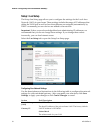28 4021192 Rev A
How Do I Connect My Gateway for Internet and Telephone Service?
5 Connect one end of a telephone jumper cable (not included) to a telephone outlet
in your home or to a telephone or fax machine. Then connect the other end of the
jumper cable to the appropriate RJ-11 TELEPHONE port on the back of the
residential gateway. The telephone ports are light gray and are labeled 1/2 and 2
or 1 and 2 depending on the region of the world the residential gateway is used.
Notes:
– Make sure to connect your telephone service to the correct RJ-11 port. For
single line telephone service, connect to port 1/2 or 1.
– In North America, residential gateways have multi-line capability on the
RJ-11 telephone port labeled 1/2. Line 1 is on pins 3 and 4 of port 1/2,
and Line 2 is supported on pins 2 and 5. In Europe, residential gateways
support only one line per port. Line 1 is on port 1 and line 2 is on port 2.
– Telephones that require electrical connectors other than RJ-11 may
require an external adapter (sold separately).
6 Locate the AC power cord provided with your residential gateway. Insert one
end of the power cord into the AC connector on the back of the residential
gateway. Then, plug the AC power cord into an AC outlet to power-up the
residential gateway. The residential gateway will perform an automatic search to
locate and sign on to the broadband data network. This process may take up to 2-
5 minutes. The modem will be ready for use when the POWER, DS, US and
ONLINE LEDs on the front panel of the residential gateway stop blinking and
remain on continuously.
7 Plug in and power on your PC and other home network devices. The LINK LED
on the residential gateway corresponding to the connected devices should be on
or blinking.
8 Once the residential gateway is online, most Internet devices will have
immediate Internet access.
Note: If your PC does not have Internet access, refer to Frequently Asked
Questions (on page 94) for information on how to configure your PC for TCP/IP.
For Internet devices other than PCs, refer to the DHCP or IP Address
configuration section of the User Guide or Operations Manual for those devices.


















